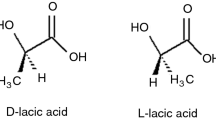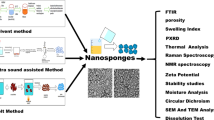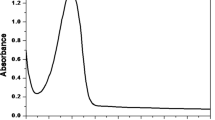Abstract
The aim of this study was to formulate nanoparticles from poly(I)lactide by a modified nanoprecipitation method. The main focus was to study the effect of cosolvent selection on the shape, size, formation efficiency, degree of crystallinity, x-ray diffraction (XRD) reflection pattern, and zeta potential value of the particles. Low-molecular-weight (2000 g/mol) poly(I)lactide was used as a polymer, and sodium cromoglycate was used as a drug. Acetone, ethanol, and methanol were selected as cosolvents. Optimal nanoparticles were achieved with ethanol as a cosolvent, and the formation efficiency of the particles was also higher with ethanol as compared with acetone or methanol. The particles formulated by ethanol and acetone appeared round and smooth, while with methanol they were slightly angular. When the volume of the inner phase was decreased during the nanoprecipitation process, the mean particle size was also decreased with all the solvents, but the particles were more prone to aggregate. The XRD reflection pattern and the degree of crystallinity were more dependent were more prone to aggregate. The XRD reflection pattern and the degree of crystallinity were more dependent on the amount of the solvents in the inner phase than on the properties of the individual cosolvents. The zeta potential values of all the particle batches were slightly negative, which partially explains the increased tendency toward particle aggregation.
Similar content being viewed by others
References
Masinde LE, Hickey AJ. Aerosolized aqueous suspensions of poly(l-lactic acid) microspheres. Int J Pharm. 1993;100:123–131.
Zhang Q, Shen Z, Nagai T. Prolonged hypoglycemic effect of insulin-loaded polybutylcyanoacrylate nanoparticles after pulmonary administration to normal rats. Int J Pharm. 2001;218:75–80.
Kostanski JW, DeLuca PP. A novel in vitro release technique for peptide-containing biodegradable microspheres. AAPS PharmSciTech. 2000;1(1):article 4. www.aapspharmscitech.org/scientificjournals/pharmscitech/volume.1issue1/111/manuscript.htm.
Martin TM, Bandi N, Shulz R, Roberts CB, Kompella UB. Preparation of budesonide and budesonide-PLA microparticles using super-critical fluid precipitation technology. AAPS PharmSciTech. 2002;3(3):article 18. www.aapspharmscitech.org/scientificjournals/pharmscitech/volume3issue3/pt030318/pt030318.htm.
Perugini P, Genta I, Conti B, Modena T, Pavanetto F. Long-term release of clodronate from biodegradable microspheres. AAPS PharmSciTech. 2001;2(3):article 10. www.aapspharmscitech.org/scientificjournals/pharmscitech/volume2issue3/1018/manuscript.htm.
Jonnalagadda S, Robinson DH. A bioresorbable, polylactide reservoir for diffusional and osmotically controlled drug delivery. 00AAPS PharmSciTech. 2000;1(4):article 29. www.aapspharmscitech.org/scientificjournals/pharmscitech/volume1issue4/039/manuscript.htm.
Lescure F, Seguin C, Breton P, Roy D, Couvreur P. Preparation and characterization of novel poly(methylidene malonate 2.1.2)-made nanoparticles. Pharm Res. 1994;11:1270–1277.
Fessi H, Puisieux F, Devissaguet JP, Ammoury N, Benita S. Nanocapsule formation by interfacial polymer deposition following solvent displacement. Int J Pharm. 1989;55:R1-R4.
Ammoury N, Fessi H, Devissaguet JP, Dubrasquet M, Benita S. Jejunal absorption, pharmacological activity, and pharmacokinetic evaluation of indomethacin-loaded poly(d,l-lactide) and poly(isobutylcyanoacrylate) nanocapsules in rats. Pharm Res. 1991;8:101–105.
Verger ML-L, Fluckiger L, Kim Y-I, Hoffman M, Maincent P. Preparation and characterization of nanoparticles containing an antihypertensive agent. Eur J Pharm Biopharm. 1998;46:137–143.
Niwa T, Takeuchi H, Hino T, Kunou N, Kawashima Y. Preparations of biodegradable nanospheres of water-soluble and insoluble drugs with d,l-lactide/glycolide copolymer by a novel spontaneous emulsification solvent diffusion method, and the drug release behavior. J Control Release. 1993;25:89–98.
Wichert B, Rohdewald P. A new method for the preparation of drug containing polylactic acid microparticles without using organic solvents. J Control Release. 1990;14:269–283.
Wichert B, Rohdewald P. Low molecular weight PLA: a suitable polymer for pulmonary administered microparticles? J Microencapsul. 1993;10:195–207.
Thioune O, Fessi H, Devissaguet JP, Puisieux F. Preparation of pseudolatex by nanoprecipitation: influence of the solvent nature on intrinsic viscosity and interaction constant. Int J Pharm. 1997;146:233–238.
Jeffery H, Davis SS, OHagan DT. The preparation and characterisation of poly(lactide-co-glycolide) microparticles. I: Oil-in-water emulsion solvent evaporation. Int J Pharm. 1991;77:169–175.
Wehrle P, Magenheim B, Benita S. The influence of process parameters on the PLA nanoparticle size distribution, evaluated by means of factorial design. Eur J Pharm Biopharm. 1995;41:19–26.
Molpeceres J, Guzman M, Aberturas MR, Chacon M, Berges L. Application of central composite designs to the preparation of polycaprolactone nanoparticles by solvent displacement. J Pharm Sci. 1996;85:206–213.
Murakami H, Kobayashi M, Takeuchi H, Kawashima Y. Preparation of poly(dl-lactide-co-glycolide) nanoparticles by modified spontaneous emulsification solvent diffusion method. Int J Pharm. 1999;187:143–152.
Herrmann J, Bodmeier R. Biodegradable, somatostatin acetate containing microspheres prepared by various aqueous and non-aqueous solvent evaporation methods. Eur J Pharm Biopharm. 1998;45:75–82.
Devissaguet J-P, Fessi H, Puisieux F. Process for the preparation of dispersible colloidal systems of a substance in the form of nanocapsules. US Patent 5 049 322. September 17, 1991.
Mehta RC, Thanoo BC, DeLuca PP. Peptide containing microspheres from low molecular weight and hydrophilic poly(d,l-lactide-coglycolide). J Control Release. 1996;41:249–257.
Ueda M, Kreuter J. Optimization of the preparation of loperamide-loaded poly(L-lactide) nanoparticles by high pressure emulsification-solvent evaporation. J Microencapsul. 1997;14:593–605.
Murakami H, Kobayashi M, Takeuchi H, Kawashima Y. Further application of a modified spontaneous emulsification solvent diffusion method to various types of PLGA and PLA polymers for preparation of nanoparticles. Powder Technol. 2000;107:137–143.
Cox JSG, Woodard GD, McCrone WC. Solid-state chemistry of cromolyn sodium (disodium cromoglycate). J Pharm Sci. 1971;60:1458–1465.
Chen LR, Young VG Jr, Lechuga-Ballesteros D, Grant DJW. Solid-state behavior of cromolyn sodium hydrates. J Pharm Sci. 1999;88:1191–1200.
Müller RH, Kayser CJO. Nanosuspensions as particulate drug formulations in therapy: rationale for development and what we can expect for the future. Adv Drug Deliv Rev. 2001;47:3–19.
Konno T, Kurita K, Iwasaki Y, Nakabayashi N, Ishihara K. Preparation of nanoparticles composed with bioinspired 2-methacryloyloxyethyl phosphorylcholine polymer. Biomaterials. 2001;22:1883–1889.
Author information
Authors and Affiliations
Corresponding author
Rights and permissions
About this article
Cite this article
Peltonen, L., Koistinen, P., Karjalainen, M. et al. The effect of cosolvents on the formulation of nanoparticles from low-molecular-weight poly(I)lactide. AAPS PharmSciTech 3, 32 (2002). https://doi.org/10.1208/pt030432
Received:
Accepted:
DOI: https://doi.org/10.1208/pt030432




